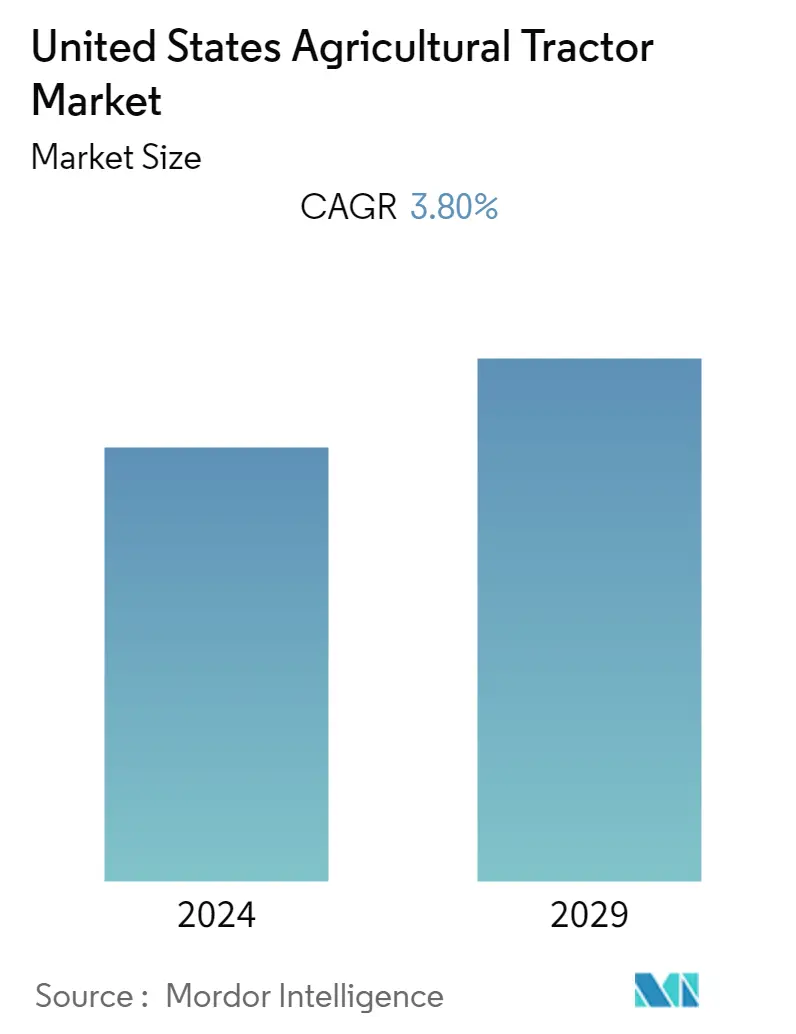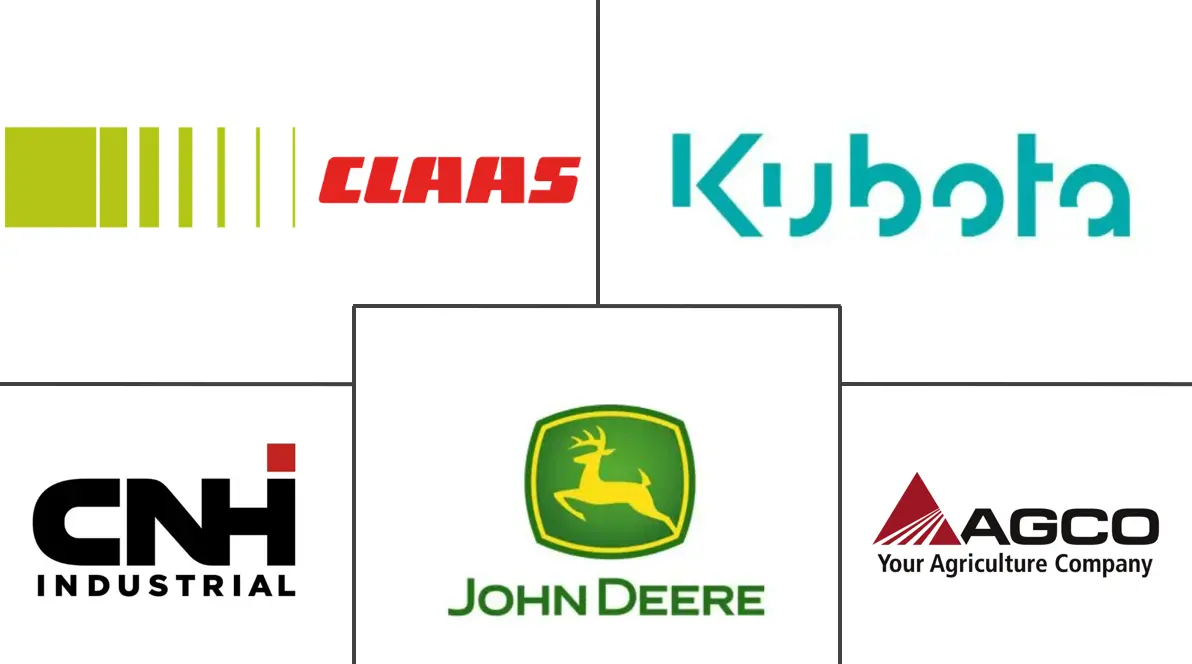Market Size of United States Agricultural Tractor Industry

| Study Period | 2019 - 2029 |
| Base Year For Estimation | 2023 |
| Forecast Data Period | 2024 - 2029 |
| Historical Data Period | 2019 - 2022 |
| CAGR | 3.80 % |
| Market Concentration | High |
Major Players
*Disclaimer: Major Players sorted in no particular order |
United States Agricultural Tractors Market Analysis
The United States agricultural tractor machinery market is set to grow at a CAGR of 3.8% during the forecast period.
- Agriculture is a major occupation in the United States, where mechanization of farming is considered an important reason for increased productivity, sales, and export. Also, the shorter replacement cycles of 9 years in advanced economies, like the United States, increase the demand for new tractors and drive the market.
- In addition, the farmers in the country have been able to avail themselves of timely subsidies on the purchases of agricultural tractors. This, in turn, has helped even small-scale farmers to invest in agricultural equipment, like tractors, in the country.
- According to data from the Quarterly Census of Employment and Wages (QCEW), wage and salary employment in agriculture (measured as the annual average number of full- and part-time jobs)-including support industries such as farm labor contracting-stabilized in the 2000s and has been on a gradual upward trend since 2010, rising from 1.07 million in 2010 to 1.16 million in 2020, a gain of 9 percent. Thus, the growing wages of farm labor are further propelling the farmers toward adopting agricultural equipment, like tractors, and boosting the market's growth.
- Some of the players in the country are involved in research and development and the launch of advanced tractors in the market. For instance, in 2021, players concentrated on producing fully electric and driver-optional tractors in the country. These tractors are being funded through the United States Department of Agriculture's (USDA) Conservation Innovation Grant program to automate specific blueberry field maintenance tasks, reducing the use of diesel fuels and enhancing farming productivity.
United States Agricultural Tractors Industry Segmentation
A tractor is a farm vehicle used to pull farm machinery and provide the energy needed for the machinery to work. For this report, tractors used in agricultural operations, especially four-wheeled tractors, have been considered. The report does not cover other agricultural machinery and attachments for tractors. Tractors used for industrial and construction purposes are also excluded from the study.
The United States agricultural tractor machinery market is segmented by horsepower into below 40 HP, 40-100 HP, and above 100 HP, and tractor type into utility tractors, row crop tractors, garden & orchard type tractors, and other tractor types.
The report offers the market size and forecasts for volume in (units) and value in (USD million) for all the above segments.
| Horse Power | |
| Below 40 HP | |
| 40-100 HP | |
| Above 100 HP |
| Tractor Type | |
| Utility Tractors | |
| Row Crop Tractors | |
| Graden & Orchard Type Tractors | |
| Other Tractor Types |
United States Agricultural Tractor Market Size Summary
The United States agricultural tractor market is poised for steady growth, driven by the mechanization of farming, which is crucial for enhancing productivity and supporting sales and exports. The shorter replacement cycles in the U.S. further stimulate demand for new tractors. Timely subsidies have enabled even small-scale farmers to invest in agricultural equipment, contributing to market expansion. The upward trend in agricultural employment and wages has also encouraged farmers to adopt tractors, boosting market growth. Innovations in tractor technology, such as fully electric and driver-optional models, are being supported by government programs to enhance efficiency and reduce reliance on diesel fuels.
The demand for row-crop tractors is increasing due to the scarcity of farm laborers and the need for mechanization in agriculture. These tractors are essential for various agricultural tasks and are designed to minimize crop damage. The market is expected to grow as the acreage of crops expands. The U.S. agricultural tractor market is highly consolidated, with major players focusing on new product launches, partnerships, and acquisitions to maintain their market share. Investments in research and development, along with the introduction of advanced tractor models, are key strategies for future growth. Companies like John Deere and Kubota are expanding their product lines and facilities to meet the evolving needs of North American customers, further driving market development.
United States Agricultural Tractor Market Size - Table of Contents
-
1. MARKET DYNAMICS
-
1.1 Market Overview
-
1.2 Market Drivers
-
1.3 Market Restraints
-
1.4 Porter's Five Forces Analysis
-
1.4.1 Threat of New Entrants
-
1.4.2 Bargaining Power of Buyers/Consumers
-
1.4.3 Bargaining Power of Suppliers
-
1.4.4 Threat of Substitute Products
-
1.4.5 Intensity of Competitive Rivalry
-
-
-
2. MARKET SEGMENTATION
-
2.1 Horse Power
-
2.1.1 Below 40 HP
-
2.1.2 40-100 HP
-
2.1.3 Above 100 HP
-
-
2.2 Tractor Type
-
2.2.1 Utility Tractors
-
2.2.2 Row Crop Tractors
-
2.2.3 Graden & Orchard Type Tractors
-
2.2.4 Other Tractor Types
-
-
United States Agricultural Tractor Market Size FAQs
What is the current United States Agricultural Tractor Market size?
The United States Agricultural Tractor Market is projected to register a CAGR of 3.80% during the forecast period (2024-2029)
Who are the key players in United States Agricultural Tractor Market?
CLAAS KGaA mbH, Deere & Company, CNH Industrial N.V., Kubota Corporation and AGCO Corporation are the major companies operating in the United States Agricultural Tractor Market.

